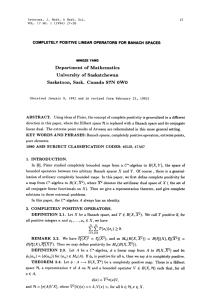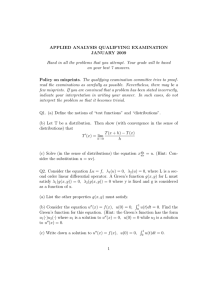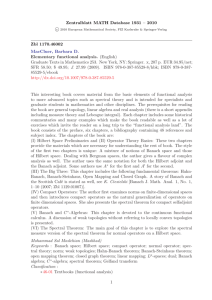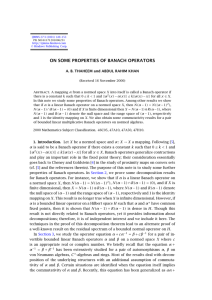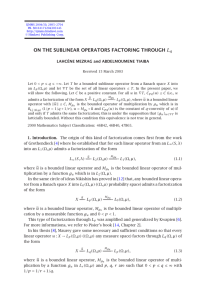ON SOME PROPERTIES OF BANACH OPERATORS. II
advertisement
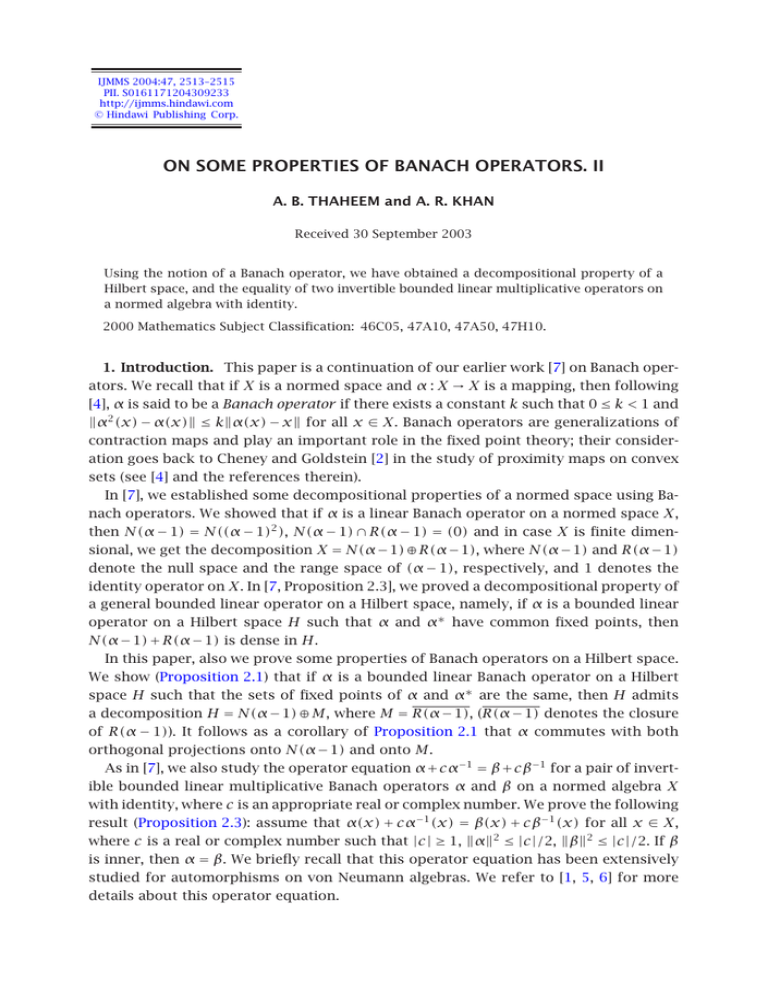
IJMMS 2004:47, 2513–2515 PII. S0161171204309233 http://ijmms.hindawi.com © Hindawi Publishing Corp. ON SOME PROPERTIES OF BANACH OPERATORS. II A. B. THAHEEM and A. R. KHAN Received 30 September 2003 Using the notion of a Banach operator, we have obtained a decompositional property of a Hilbert space, and the equality of two invertible bounded linear multiplicative operators on a normed algebra with identity. 2000 Mathematics Subject Classification: 46C05, 47A10, 47A50, 47H10. 1. Introduction. This paper is a continuation of our earlier work [7] on Banach operators. We recall that if X is a normed space and α : X → X is a mapping, then following [4], α is said to be a Banach operator if there exists a constant k such that 0 ≤ k < 1 and α2 (x) − α(x) ≤ kα(x) − x for all x ∈ X. Banach operators are generalizations of contraction maps and play an important role in the fixed point theory; their consideration goes back to Cheney and Goldstein [2] in the study of proximity maps on convex sets (see [4] and the references therein). In [7], we established some decompositional properties of a normed space using Banach operators. We showed that if α is a linear Banach operator on a normed space X, then N(α − 1) = N((α − 1)2 ), N(α − 1) ∩ R(α − 1) = (0) and in case X is finite dimensional, we get the decomposition X = N(α −1)⊕R(α −1), where N(α −1) and R(α −1) denote the null space and the range space of (α − 1), respectively, and 1 denotes the identity operator on X. In [7, Proposition 2.3], we proved a decompositional property of a general bounded linear operator on a Hilbert space, namely, if α is a bounded linear operator on a Hilbert space H such that α and α∗ have common fixed points, then N(α − 1) + R(α − 1) is dense in H. In this paper, also we prove some properties of Banach operators on a Hilbert space. We show (Proposition 2.1) that if α is a bounded linear Banach operator on a Hilbert space H such that the sets of fixed points of α and α∗ are the same, then H admits a decomposition H = N(α − 1) ⊕ M, where M = R(α − 1), (R(α − 1) denotes the closure of R(α − 1)). It follows as a corollary of Proposition 2.1 that α commutes with both orthogonal projections onto N(α − 1) and onto M. As in [7], we also study the operator equation α+cα−1 = β+cβ−1 for a pair of invertible bounded linear multiplicative Banach operators α and β on a normed algebra X with identity, where c is an appropriate real or complex number. We prove the following result (Proposition 2.3): assume that α(x) + cα−1 (x) = β(x) + cβ−1 (x) for all x ∈ X, where c is a real or complex number such that |c| ≥ 1, α2 ≤ |c|/2, β2 ≤ |c|/2. If β is inner, then α = β. We briefly recall that this operator equation has been extensively studied for automorphisms on von Neumann algebras. We refer to [1, 5, 6] for more details about this operator equation. 2514 A. B. THAHEEM AND A. R. KHAN 2. The results Proposition 2.1. Let α be a bounded linear Banach operator on a Hilbert space H such that the sets of fixed points of α and α∗ are the same. Then the following hold: (i) N(α − 1)⊥R(α − 1), (ii) H = N(α − 1) ⊕ M, where M = R(α − 1). Proof. To prove (i), let x ∈ N(α − 1) and y ∈ R(α − 1). Then α(x) = x and y = α(z) − z for some z ∈ H. Therefore, α∗ (x) = x and hence x, y = x, α(z) − z = x, α(z) − x, z = α∗ (x), z − x, z = x, z − x, z = 0. (2.1) Thus N(α − 1)⊥R(α − 1). To prove (ii), it is enough to show that N(α − 1) = M ⊥ . By (i) and the continuity of α, N(α − 1)⊥M. So, N(α − 1) ⊆ M ⊥ . Conversely, assume that z ∈ M ⊥ . Then z, y = 0 for all y ∈ M; in particular, z, (α − 1)x = 0 for all x ∈ H because R(α − 1) ⊆ M. Thus z, α(x) = z, x for all x ∈ H. So, α∗ (z), x = z, x for all x ∈ H. This shows that α∗ (z) − z, x = 0 for all x ∈ H. Therefore, α∗ (z) − z = 0 or α∗ (z) = z, that is, z is a fixed point of α∗ and hence by assumption, α(z) = z, that is, z ∈ N(α − 1). So, M ⊥ ⊆ N(α − 1). Thus N(α − 1) = M ⊥ and hence H = N(α − 1) ⊕ M. Corollary 2.2. Let α be a bounded linear Banach operator on a Hilbert space H such that the sets of fixed points of α and α∗ are the same. Then α commutes with both orthogonal projections, onto N(α − 1) and onto M. Proof. Since R(α − 1) is α-invariant, so is M. Also, M ⊥ = N(α − 1) is α-invariant. Thus M reduces α and hence α commutes with both orthogonal projections, onto N(α − 1) and onto M [3]. It easily follows that the orthogonal projection P onto N(α−1) is the largest orthogonal projection such that αP = P . We conclude this paper with a result about an operator equation similar to the one considered in [7]. Proposition 2.3. Let α, β be invertible bounded linear multiplicative Banach operators on a normed algebra X with identity such that α(x)+cα−1 (x) = β(x)+cβ−1 (x) for all x ∈ X, where c is a real or complex number with |c| ≥ 1, α2 ≤ |c|/2, β2 ≤ |c|/2. If β is inner, then α = β. Proof. It follows from [7, Proposition 3.2] that α and β commute. Therefore, (αβ − c) β−1 − α−1 (x) = α(x) − αβα−1 (x) − cβ−1 (x) + cα−1 (x) = α(x) − βα α−1 (x) − cβ−1 (x) + cα−1 (x) = α(x) − β(x) − cβ−1 (x) + cα−1 (x) = α(x) + cα−1 (x) − β(x) + cβ−1 (x) = 0. (2.2) ON SOME PROPERTIES OF BANACH OPERATORS. II 2515 Put (β−1 −α−1 )(x) = y. Then we obtain (αβ−c)(y) = 0, that is, αβ(y) = cy. Therefore, by assumption, we get |c|y = cy = αβ(y) ≤ αβy ≤ (|c|/2)y, that is, |c|y ≤ (|c|/2)y. This implies that y = 0 and hence (β−1 − α−1 )(x) = 0 for all x ∈ X, that is, β−1 (x) = α−1 (x) for all x ∈ X. Since α is onto, therefore replacing x by α(x), we get β−1 (α(x)) = x or α(x) = β(x) for all x ∈ X. Acknowledgments. The authors are grateful to King Fahd University of Petroleum and Minerals and Saudi Basic Industries Corporation (SABIC) for supporting Fast Track Research Project no. FT-2002/01. We also thank the referees for useful suggestions. The second author is on leave from Bahauddin Zakariya University, Multan, Pakistan, and is indebted to the university’s authorities for granting leave. References [1] [2] [3] [4] [5] [6] [7] F. S. Cater and A. B. Thaheem, On certain equations of automorphisms of C ∗ -algebras, Southeast Asian Bull. Math. 27 (2003), no. 2, 193–207. W. Cheney and A. A. Goldstein, Proximity maps for convex sets, Proc. Amer. Math. Soc. 10 (1959), 448–450. P. A. Fuhrmann, Linear Systems and Operators in Hilbert Spaces, McGraw-Hill, New York, 1981. S. A. Naimpally, K. L. Singh, and J. H. M. Whitfield, Fixed points and nonexpansive retracts in locally convex spaces, Fund. Math. 120 (1984), no. 1, 63–75. A. B. Thaheem, On certain decompositional properties of von Neumann algebras, Glasgow Math. J. 29 (1987), no. 2, 177–179. , On certain pairs of normal operators, New Zealand J. Math. 30 (2001), no. 1, 87–92. A. B. Thaheem and A. R. Khan, On some properties of Banach operators, Int. J. Math. Math. Sci. 27 (2001), no. 3, 149–153. A. B. Thaheem: Department of Mathematical Sciences, King Fahd University of Petroleum and Minerals, Dhahran 31261, Saudi Arabia E-mail address: athaheem@kfupm.edu.sa A. R. Khan: Department of Mathematical Sciences, King Fahd University of Petroleum and Minerals, Dhahran 31261, Saudi Arabia E-mail address: arahim@kfupm.edu.sa



